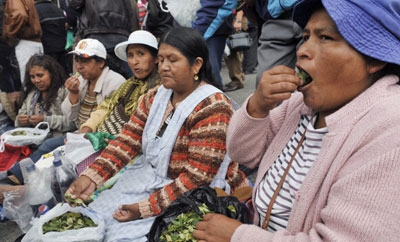Bolivia’s long-awaited coca use study has found the country needs to cultivate over 14,000 hectares of the crop to satisfy legal demand, a number more than double opposition claims but just slightly over half of current production.
According to information released by the Bolivian government, 14,705 hectares of coca — with each hectare estimated to produce 1,475 kilos of coca leaf per year — are needed to satisfy a 20,690 ton legal demand for coca leaf and coca derived products. The majority of consumption is attributed to households, accounting for 19,138 tons with over 3 million users and rising, followed by commercial sales in the border regions.
The largest proportion of users observed in the study — 37 percent — said they used the leaves for chewing, while 31 percent said they used them for medicinal purposes. Senator Fidel Surco of the ruling Movement Toward Socialism (MAS) explained that the study established that each coca chewer uses about six kilos of leaf per year, reported La Razon.

InSight Crime Analysis
The number cited in the study represents a slight increase on the current legal cap of 12,000 hectares of coca, but remains well below the 20,000 hectares limit coca growers have attempted to secure and the 25,300 actually produced, according to United Nations figures.
SEE ALSO: Coverage of Coca
The study has been carried out in a highly politicized climate, with Morales, still leader of one of the coca unions, pushing for pro-coca policies to placate his political base, while the political opposition push for a hard line against growers. The report has become a political football in this battle, with the government delaying its release for several years to complete “complementary studies,” while recently an opposition politician claimed he had seen an advance copy that stated only 6,000 hectares were needed for legal use.
Nevertheless, there is plenty of reason to believe in the veracity of the report’s findings. Kathryn Ledebur, director of the Bolivia-based Andean Information Network and an expert on the issue, told InSight Crime that the new figure seems “reasonable and credible.” The number is also supported by a study by Vanderbilt University’s Latin American Public Opinion Project (LAPOP), which found 36 percent of Bolivians chew coca leaves.
However, although current production is nearly double the necessary amount determined by the study, the results are unlikely to be put to immediate use. Upping eradication efforts right away would be socially, economically and politically unviable for the government, particularly in the face of recent anti-eradication uprisings.

